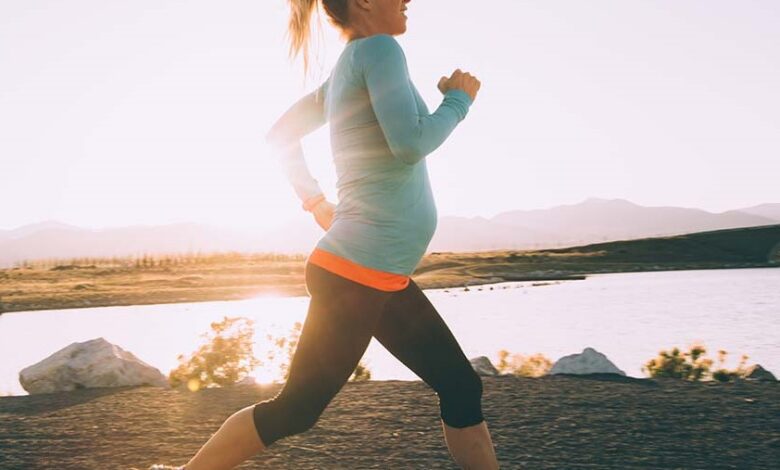Is it Safe to Exercise in the Heat During Pregnancy?

During the dog days of summer, you may prefer to stay indoors when exercising. However, if you enjoy the heat, or prefer activities that lend themselves to the outdoors — like running, biking, hiking, etc. — you may be wondering if you can safely exercise in heat during pregnancy. After all, if you’re pregnant, you’ve probably been told to minimize exposure to heat and avoid things like saunas, hot baths, and exercise in the heat.
But why is that? Where does caution come from regarding heat exposure during pregnancy, and how can you make sure your preferred form of physical activity is safe?
This article will help you understand the basis for concern about overheating during pregnancy, provide you with the latest research on this topic, and most importantly, provide a simple guide to help you stay safe while enjoying types of activities you like.
Where Concerns About Overheating During Pregnancy Come From
When the body is pregnant, keeping the fetus safe and developing is of the utmost importance. And with regard to fetal body temperature, preventing it from climbing higher than baseline is critical, especially in the first trimester. This is because important organ development takes place during this time and those processes can be affected by high spikes in body temperature.
It is important to understand that the body temperature of the fetus depends on maternal body temperature. The successful research done on this topic (from the 1960s) is performed on animals. This research has shown that when the mother’s body temperature is too high (above 102° Fahrenheit), it can result in birth defects, especially earlier in the first trimester, when critical development of the brain and organs takes place (Edwards, 1967). Here comes guidance to limit heat exposure during pregnancy.
The Fascinating Ways the Pregnant Body Heats Up
While the above research findings may seem concerning, do not fear, because the pregnant body adapts naturally to allow for greater heat dissipation. In particular, the following changes occur:
- Sweating begins at a lower body temperature. You start sweating earlier to cool down.
- More heat is lost through respiration. Respiratory rate increases by 50% during pregnancy (ACE, 2011).
- There is increased skin-to-environment heat transfer. Due to increased blood flow during pregnancy.
So, even exercise doing increase the body temperature, the natural adaptations of the pregnant body help to protect against any possible danger to the fetus. That said, it’s still important to follow the safety guidelines below to make sure you don’t do anything to hinder your body’s ability to lose heat.
What New Research Shows
The most recent research, from 2019, looked at body temperature in humans, and that was determined people can safely exercise in warmer conditions than previously thought.
In particular, it said that pregnant women can safely exercise for up to 35 minutes at 80 to 90 percent max heart rate at 77° at 45% relative humidity (Ravenelli et. al, 2019). In addition, exercising in water and spending time in saunas are considered safe, as long as certain safety guidelines (outlined below) are followed.
Guidelines for Safe Heat Exposure During Pregnancy
Although the pregnant woman’s body naturally adapts to allow more heat removal, it is important to avoid those conditions that can make heat removal difficult. Therefore, it is recommended avoid the following (Ravenelli et. al, 2019):
- Prolonged (>35 min), high-intensity exercise in heat greater than 77° F and 45% relative humidity
- Immersion in water (>92° F) for more than 45 min
- Saunas (>20 min) above 158° F and 15% relative humidity
- Hot tubs/baths (>104°) F for more than 20 min
- Hot yoga
In addition to avoiding the activities above, here are some additional tips to reduce the risk of overheating:
- Drink water! Hydration is important for so many reasons during pregnancy, including enabling you to sweat constantly
- Wear clothing that allows sweat to evaporate
- If exercising outside, do it during cooler times of the day (avoid 10am-4pm)
If you follow the guidelines above, and you don’t have any pre-existing conditions, rest assured that you can exercise in warmer conditions and still experience a safe and healthy pregnancy.
Additional Resources
For additional resources to help you exercise safely and effectively during pregnancy, see our prenatal programs and services. You’ll find a variety of offers — including education, self-guided training programsand the ability work with an expert coach — to help you feel empowered, confident, and empowered throughout your journey from pregnancy to parenthood.
Are you a Health & Fitness Professional?
If you are a health and fitness professional interested in learning more about coaching pre and postnatal clients, explore our Pre & Postnatal Professional Education. We offer in-depth education to become ProNatal Certified for those who wish to specialize in training this population, and a Mini Course for GroupX instructors who just need the basics.
Sources:
American Council on Exercise. (2011). ACE Group Fitness Instructor Manual: A Guide for Fitness Professionals. San Diego, Print.
Edwards. MJ (1967). Congenital defects in guinea pigs. Following induced hyperthermia during pregnancy. Arch Pathol., 84(1):42-8.
Ravanelli, N., Casasola, W., English, T., Edwards, KM, Jay, O. (2019). Heat stress and fetal risk. Environmental limitations for exercise and passive heat stress during pregnancy: a systematic review with best evidence synthesis. British Journal of Sports Medicine53(13), 799-805.





